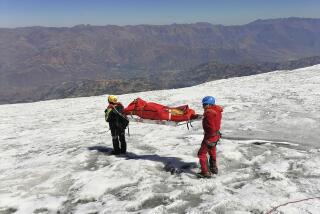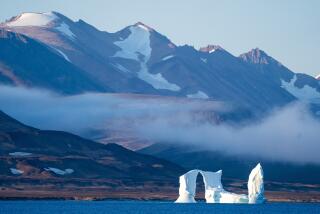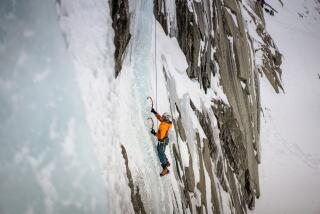Greenland’s Ice Sheet Is Slip-Sliding Away
JAKOBSHAVN GLACIER, Greenland — Gripping a bottle of Jack Daniel’s between his knees, Jay Zwally savored the warmth inside the tiny plane as it flew low across Greenland’s biggest and fastest-moving outlet glacier.
Mile upon mile of the steep fjord was choked with icy rubble from the glacier’s disintegrated leading edge. More than six miles of the Jakobshavn had simply crumbled into open water.
“My God!” Zwally shouted over the hornet whine of the engines.
From satellite sensors and seasons in the field, Zwally, 67, knew the ice sheet below in a way that few could match. Even after a lifetime of study, the raffish NASA glaciologist with a silver dolphin in one pierced ear was dismayed by how quickly the breakup had occurred.
Wedged between boxes of scientific instruments, tent bags, duffels and survival gear, Zwally had no room to turn inside the cramped passenger compartment of the twin-engine Otter. He passed the whiskey bottle over his shoulder to geophysicist Jose Rial from the University of North Carolina, squeezed on a jump seat between a surveyor and a sleeping climatologist.
Homeward bound -- windburned, bone-chilled and greasy after weeks on this immense ice cap tilted like a beret flopped across the top of the world -- they all had been in a celebratory mood.
Somber now, Zwally and Rial shared a drink in silence as the shadow of the plane slipped across azure meltwater lakes, rust-red tundra and silver tongues of ice.
*
The Greenland ice sheet -- two miles thick and broad enough to blanket an area the size of Mexico -- shapes the world’s weather, matched in influence by only Antarctica in the Southern Hemisphere.
It glows like milky mother-of-pearl. The sheen of ice blends with drifts of cloud as if snowbanks are taking flight.
In its heartland, snow that fell a quarter of a million years ago is still preserved. Temperatures dip as low as 86 degrees below zero. Ground winds can top 200 mph. Along the ice edge, meltwater rivers thread into fraying brown ropes of glacial outwash, where migrating herds of caribou and musk ox graze.
The ice is so massive that its weight presses the bedrock of Greenland below sea level, so all-concealing that not until recently did scientists discover that Greenland actually might be three islands.
Should all of the ice sheet ever thaw, the meltwater could raise sea level 21 feet and swamp the world’s coastal cities, home to a billion people. It would cause higher tides, generate more powerful storm surges and, by altering ocean currents, drastically disrupt the global climate.
Climate experts have started to worry that the ice cap is disappearing in ways that computer models had not predicted.
By all accounts, the glaciers of Greenland are melting twice as fast as they were five years ago, even as the ice sheets of Antarctica -- the world’s largest reservoir of fresh water -- also are shrinking, researchers at NASA’s Jet Propulsion Laboratory and the University of Kansas reported in February.
Zwally and other researchers have focused their attention on a delicate ribbon -- the equilibrium line, which marks the fulcrum of frost and thaw in Greenland’s seasonal balance.
The zone runs around the rim of the ice cap like a drawstring. Summer melting, on average, offsets the annual accumulation of snow.
Across the ice cap, however, the area of seasonal melting was broader last year than in 27 years of record-keeping, University of Colorado climate scientists reported. In early May, temperatures on the ice cap some days were almost 20 degrees above normal, hovering just below freezing.
From cores of ancient Greenland ice extracted by the National Science Foundation, researchers have identified at least 20 sudden climate changes in the last 110,000 years, in which average temperatures fluctuated as much as 15 degrees in a single decade.
The increasingly erratic behavior of the Greenland ice has scientists wondering whether the climate, after thousands of years of relative stability, may again start oscillating.
The Theory at Work
Huddled inside a red cook tent atop 3,900 feet of ice, Zwally shoveled snow into a pot simmering on a two-ring propane camp stove.
He had to melt enough to boil lobster tails for dinner. Zwally, who works at NASA’s Goddard Space Flight Center in Greenbelt, Md., had purchased them at Costco and lugged them to Greenland.
The beating wings of a 30-mph wind slapped against the tent fabric. Every 15 minutes, a gust sucked open the door and frosted the room.
The tent -- buried in drifts and entered by a ladder through a hatch in the roof -- was part of Swiss Camp, located 155 miles north of the Arctic Circle.
For those assessing the effect of global warming, there may be no more perfect place than this warren of red tents on the Northern Hemisphere’s largest ice cap. Here, the theoretical effects seen in computerized climate models take tangible form.
University of Colorado climatologist Konrad Steffen set up Swiss Camp in 1990 to study the weather along the equilibrium line. As a precaution, Steffen, 54, built the camp on a plywood platform to keep it afloat when the ice turns into summer slush and open lakes before refreezing in the fall.
Even so, Steffen and Zwally often spent days chiseling out tables and chairs had frozen in floodwater into a single block of ice.
Zwally joined his colleagues there on May 8 in the regular spring migration of scientists to the Arctic.
He has been coming to Swiss Camp every year since 1994 and has been studying the polar regions since 1972, monitoring the polar ice through satellite sensors.
Eventually he realized he had to study the ice firsthand.
The ice sheet seemed such a stolid reservoir of cold that many experts had been confident of it taking centuries for higher temperatures to work their way thousands of feet down to the base of the ice cap and undermine its stability.
By and large, computer models supported that view, predicting that as winter temperatures rose, more snow would fall across the dome of the ice cap. Thus, by the seasonal bookkeeping of the ice sheet, Greenland would neatly balance its losses through new snow.
Indeed, Zwally and his colleagues in March released an analysis of data from two European remote-sensing satellites showing the amount of water locked up in the ice sheet had risen slightly between 1992 and 2002.
Then the ice sheet began to confound computer-generated predictions.
By 2005, Greenland was beginning to lose more ice volume than anyone expected -- an annual loss of up to 52 cubic miles a year -- according to more recent satellite gravity measurements released by JPL.
The amount of freshwater ice dumped into the Atlantic Ocean has almost tripled in a decade.
“We are clearly seeing the effects of climate change starting to kick in,” Zwally said.
Since Steffen started monitoring the weather at Swiss Camp in 1991, the average winter temperature has risen almost 10 degrees. Last year, the annual melt zone reached farther inland and up to higher elevations than ever before.
There was even a period of melting in December.
“We have never seen that,” Steffen said, combing the ice crystals from his beard. “It is significantly warmer now, and it happened quite suddenly. This year, the temperatures were warmer than I have ever experienced.”
At this time of year, the sun never sets, and at Swiss Camp, the pace of field work slackens only for dinner.
Layered in fleece, the field researchers gathered around a makeshift plywood table littered with heels of whole grain bread, pots of raspberry jam and crumbs of granola. A ridge of ice 6 inches high encased an electrical cable running between their feet.
Their cheeks were coarse with stubble. Their hair rose in waxy spikes. Their eyes had reddened from insomnia and too much midnight sun.
While one researcher spooned out the first course -- pasta in a sauce of sun-dried tomatoes -- another opened the last bottle of the 2003 Cotes du Rhone.
Zwally tended the pot on the stove.
The Greenland ice sheet was in the same predicament as his frozen lobsters, steaming in meltwater.
Getting Into the Ice
The pilot refused to land. There were too many crevasses.
Steffen waved him on to fly farther inland. He checked their position by satellite every few hundred yards.
After 34 years in the Arctic, Steffen was attuned to its subtleties. Where a novice could only see a monochromatic plain stretching to the horizon, Steffen could discern the undulating outlines left by seasonal lakes and riverbeds.
Clear of the hazard, the Otter touched down and glided on its skis to a halt on an inviting featherbed of snow.
Steffen and his crew unloaded crates of equipment and began drilling into the ice. Zwally, stripping wires with bare fingers in the biting wind, hooked up a satellite receiver.
Within the hour, they erected a tall mast festooned with monitoring instruments.
They continued to hopscotch by air across the ice sheet, planting sensors at every stop.
As spring comes earlier each year, alpine glaciers recede, hurricanes gather power and other signs of climate change accrue, the research team tries to understand how the Greenland ice sheet can respond so quickly to rising temperatures.
“How does climate change get into the ice?” Zwally asked.
Most of the computer models on which climate predictions are based did not take the dynamics of the glaciers into account.
Contrary to appearances, the monolith of ice is constantly on the move, just as Southern California, driven by plate tectonics, inches every year toward Alaska.
In that sense, the Swiss Camp is a measure of shifting property values.
The camp has been rafting on the ice stream toward the sea, on average, at about 1 foot every day. Since Steffen pitched the main tents, the camp has moved about a mile downhill.
When Zwally started tracking the velocity of the ice with Global Positioning System sensors in 1996, the ice flow maintained a steady pace all year.
But he soon discovered that the ice around Swiss Camp had abruptly shifted gears in the summer, moving faster when the surface ice started to melt. By 1999, the ice stream had almost tripled its speed to about 3 feet a day.
In an influential paper published in Science, Zwally surmised that the ice sheets had accelerated in response to warmer temperatures, as summer meltwater lubricated the base of the ice sheet and allowed it to slide faster toward the sea.
In a way no one had detected, the warm water made its way through thousands of feet of ice to the bedrock -- in weeks, not decades or centuries.
So much water streamed beneath the ice that in high summer the entire ice sheet near Swiss Camp briefly bulged 2 feet higher, like the crest of a subterranean wave.
“This meltwater acceleration is new,” Zwally said. “The significance of this is that it is a mechanism for climate change to get into the ice.”
To better track the seasonal movements, Zwally and Steffen set up two new GPS stations around Swiss Camp, while a team led by University of Vermont geophysicist Tom Neumann erected an additional 10 GPS sensors to map the changing velocity of the local ice.
At the same time, University of Texas physicist Ginny Catania pulled an ice-penetrating radar in a search pattern around the camp, seeking evidence of any melt holes or drainage crevices that could so quickly channel the hot water of global warming deep into the ice.
To her surprise, she detected a maze of tunnels, natural pipes and cracks beneath the unblemished surface.
“I have never seen anything like it, except in an area where people have been drilling bore holes,” Catania said.
No one knows how much of the ice sheet is affected.
Since 2002, Greenland’s three largest outlet glaciers have started moving faster, satellite data show.
On the eastern edge of Greenland, the Kangerlussuaq Glacier, like the Jakobshavn, has surged, doubling its pace. To the west, the Helheim Glacier now appears to be moving about half a football field every day.
In all, 12 major outlet glaciers drain the ice sheet the way rivers drain a watershed, setting the pace of its release to the ocean.
If they all slide too quickly, there is a possibility that, perhaps decades from now, they could collapse suddenly and release the entire ice sheet into the ocean.
“They are like the buttresses of the high cathedral,” said Rial, the North Carolina geophysicist. “If you remove the buttress, the cathedral will collapse.”
The accelerating ice flow has been accompanied by a dramatic increase in seismic activity, as the three immense streams of ice shake the Earth in their wake.
The lurching ice has generated swarms of earthquakes up to magnitude 5.0, researchers at Harvard University and the Lamont-Doherty Earth Observatory at Columbia University reported in March.
Last year alone, the Harvard and Columbia researchers detected as many ice quakes as the total recorded from 1993 through 1996, with five times as many in the summer as in the winter months.
“Instability is the key,” Rial said.
In the Swiss Camp laboratory tent, Rial moved his finger along the jagged seismic trace displayed on his iBook screen.
The signal had been detected by the 10 sensors he had placed around the camp six days before.
The ice sheet was trembling.
More to Read
Sign up for Essential California
The most important California stories and recommendations in your inbox every morning.
You may occasionally receive promotional content from the Los Angeles Times.










